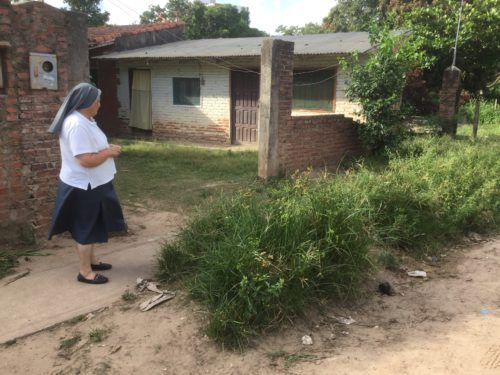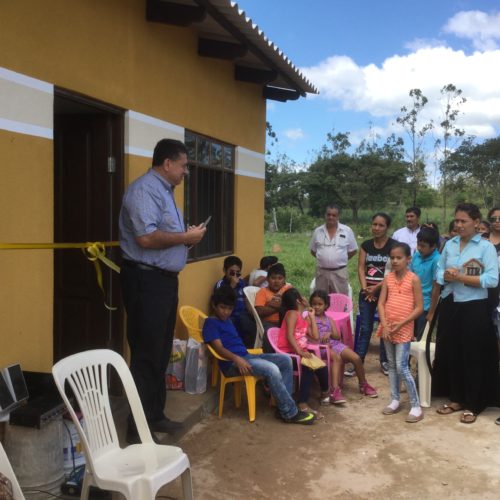It has been fun to reminisce about my trip to Bolivia last year now that Luis has returned from his visit there just a few weeks ago. When I caught up with him to hear updates about our projects, there was one in particular I couldn’t wait to ask about. While we were in Bolivia together last year for the inauguration of the Montero School, Luis had just been to Santa Cruz for yet another inauguration – the completion of homes built for women and their Children Incorporated-sponsored children, who until now had been living at Villa Emilia.
A Shining Light in the Dark

Sister Pilar pictured outside of a home constructed by Villa Emilia
When Luis and I visited Villa Emilia last spring, we were greeted by smiling children and mothers who lined the driveway leading to the community center, where the kids sang songs and read poems to welcome us.
Villa Emilia is a special place; our volunteer coordinator, Sister Pilar, and the other Sisters that run the home pull women off the streets of Santa Cruz. They give them a safe place to stay, and offer them a job in the garment factory on the property, where they make school uniforms that are sold to generate money to run the home. It is really an amazing place – well-kept grounds and small dorm-style living facilities offer the families refuge from tough street life; and the children are able to attend local schools and receive support from Children Incorporated sponsors. As a result of living in a stable environment, the children at Villa Emilia are some of the best in their classes, we’re told!
Villa Emilia isn’t set up for women to stay there permanently; once they are able to save money, the Sisters help them find housing close by, so that they can continue to work at the factory, and their children can stay in the same schools. But even more than just helping the women find housing outside of the compound, the Sisters also help the women purchase their own property, on which they can eventually build a home – offering them a real, sustainable living situation.
Sister Pilar’s Mission
The Sisters also help the women purchase their own property, on which they can eventually build a home – offering them a real, sustainable living situation.
About thirty minutes away from Villa Emilia, Sister Pilar took us to a neighborhood where she pointed out a few modest homes.
They were sturdy brick structures, and she explained that each of the homes had separate bedrooms, which was something we hadn’t seen often in smaller houses in Bolivia. Across the street from the completed houses were other homes that were still under construction.
According to Sister Pilar, the Sisters purchased the land from the government, and then the women paid the five-year mortgages on the properties, after which point they owned them outright.
Along the way, they also saved money to build homes on their properties. The timelines for the start construction varied for each family, depending on how much they could save each month. If Villa Emilia received any funding from an outside source, the Sisters would pitch in to start of construction so the women could move into permanent housing more quickly.

Luis outside of a newly built house, ready to cut the ribbon
Another ten-minute drive away, we arrived at a field where grass grew as tall as our knees, and power lines were strung above our heads. Peaking up above the grass were pipes, a sign that water lines had already been laid in the ground. Sister Pilar told us we were standing on eight plots of land, already purchased by Villa Emilia.
Eight women had been selected to pay the mortgages on the land, and they were already more than two years into their payments — but far from being able to afford to build their homes. The cost of each house would be roughly $7,000, which would take the women a long time to earn. Once they had the money, though it would take only about six months to construct the houses.
We left that day, having been touched by Sister Pilar’s mission to give these families better lives in permanent homes, and a chance to raise their children off the streets.
The Right Thing to Do
After we returned from our trip, Luis decided the right thing to do would be to have Children Incorporated support the building of the houses.
If the women were left to make the money to afford the homes on their own, it might be ten years or more before they moved in. By then, most of the sponsored children will have grown up and moved on, never having a chance to live in homes that their hardworking mothers owned.
Luis talked to Sister Pilar about sending over plans for the construction, and told her that he would like for the project to get underway as soon as possible. Knowing he would be returning to Bolivia in almost exactly a year, Luis encouraged Sister Pilar to get the project going quickly so that he could share the success with Children Incorporated supporters upon his return.
A Celebration of Home
Three weeks ago, Luis returned to Villa Emilia, and was once again greeted by a loving group of boys and girls and their mothers, as well as Sister Pilar. When he entered the community center, he saw a large bulletin board on a wall that was covered in paper hearts. Each heart had the name of an individual Children Incorporated sponsor who was helping the children at Villa Emilia. After meeting with the children, it was time to go see the new houses.
The always-ambitious Sister Pilar told Luis she would love to build more houses. There were enough plots in this new neighborhood to build fifteen more houses if they could find the funding to do so.
When Luis arrived, he no longer saw an empty field; he saw eight concrete houses making a new small neighborhood where no buildings had stood before – and the families were already there waiting for him.
The first person Luis greeted was a grandmother who has two daughters, both of whom have children in our program. They stood in front of their new home, excited that the day they had waited for a long time was finally here. Luis cut the ribbon that had been gently tied across the front door, and Sister Pilar handed the grandmother the keys to her new home. She was overwhelmed with happiness, and tears streamed down her face.
Luis spent the afternoon cutting one ribbon after another, welcoming families into their new homes. He toured the beautiful new homes, which had two separate bedrooms, a large living area, a kitchen, and a bathroom each. They had electricity, running water, sewage systems, and large windows to allow for air and light to come in.
As they left that day, the always-ambitious Sister Pilar told Luis she would love to build more houses. There were enough plots in this new neighborhood to build fifteen more houses if they could find the funding to do so; and she would even love to see a community center in the area so that the neighborhood could really flourish. She was excited to have the opportunity to contribute to the lives of these women and their children, and she was feeling so uplifted by the day that all she could talk about was doing more.
***
HOW DO I SPONSOR A CHILD IN BOLIVIA?
You can sponsor a child in Bolivia one of two ways – call our office and speak with one of our sponsorship specialists at 1-800-538-5381, or go online to our donation portal, create an account, and search for a child in Bolivia that is available for sponsorship.

